Gluten Free Pie Crust that is flaky, tender and perfect for any type of pie! Plus lots of tips for making perfect crust!
If you told me this tender, flaky, golden crust with crisp edges and perfectly cooked centers was gluten free, I would say it isn't so! This is gluten free pie crust like we've never seen before!
It is a one to one substitute for ANY pie out there. If you have a family favorite recipe but need to make it gluten free? Use this crust paired with the original filling. You will be enjoying all your favorite family flavors without the gluten!
Reasons to love this recipe:
- This gluten free pie crust works in any pie recipe!
- It is tender and flaky thanks to a couple of secret ingredients.
- Uses just 6 ingredients, and that's counting water and salt.
- Is also vegan and dairy free!
Ingredients and substitutions:
- Gluten Free Flour - for best results use Bob's Gluten Free 1 to 1 flour. This was the blend we built this recipe around and cannot guarantee results with another brand.
- Baking powder - adds lift and creates a render crust.
- Salt - to add flavor.
- Vegetable shortening - we use this brand in this recipe and recommend it for best results. You can likely swap in another vegetable shortening brand or use vegan butter or regular butter.
- Vodka - just a little creates a tender crust.
- Ice cold water - keeping it ice cold helps to create a flaky crust!
How to make gluten free pie crust:
Chill the shortening: To quickly chill your shortening, spread it out onto a small parchment lined baking sheet and place it in the freezer for 10 minutes. Once it is cold and firm to the touch, cut it into small ¼ inch pieces. Place back in the freezer until ready to use.
Whisk the dry ingredients: Whisk the flour, baking powder, and salt together in a medium bowl.
Cut in the shortening: Add in the shortening and use a pastry cutter to cut it into the flour until only small bits remain.
Add the wet ingredients: Sprinkle in the vodka and water. Stir with a spatula until combined. The dough will be crumbly, but should hold together when pressed. If it is too dry to come together, add in more water, a little at a time.
Chill: Wrap the dough and plastic wrap and chill in the fridge for at least one hour.
Roll: Roll the chilled dough out between two pieces of parchment paper. The edges will likely break when rolling, but don't worry! Peel back the top layer of parchment and fold the broken edges back over the rest of the dough. Place the top parchment back and continue rolling, the edges should smooth out.
Shape: Peel off the top layer of parchment paper. Use the bottom piece of parchment to gently flip the dough into the pie plate. Carefully peel off the remaining parchment. Ease the crust into the pie plate by lifting up on the edges and nestling it into the corners of the pie plate with your other hand. Trim off the excess dough, leaving a one inch boarder around the edge. Fold this excess under the dough so that the outer portion is twice as thick. Flute the edge of the crust.
[one-half-first]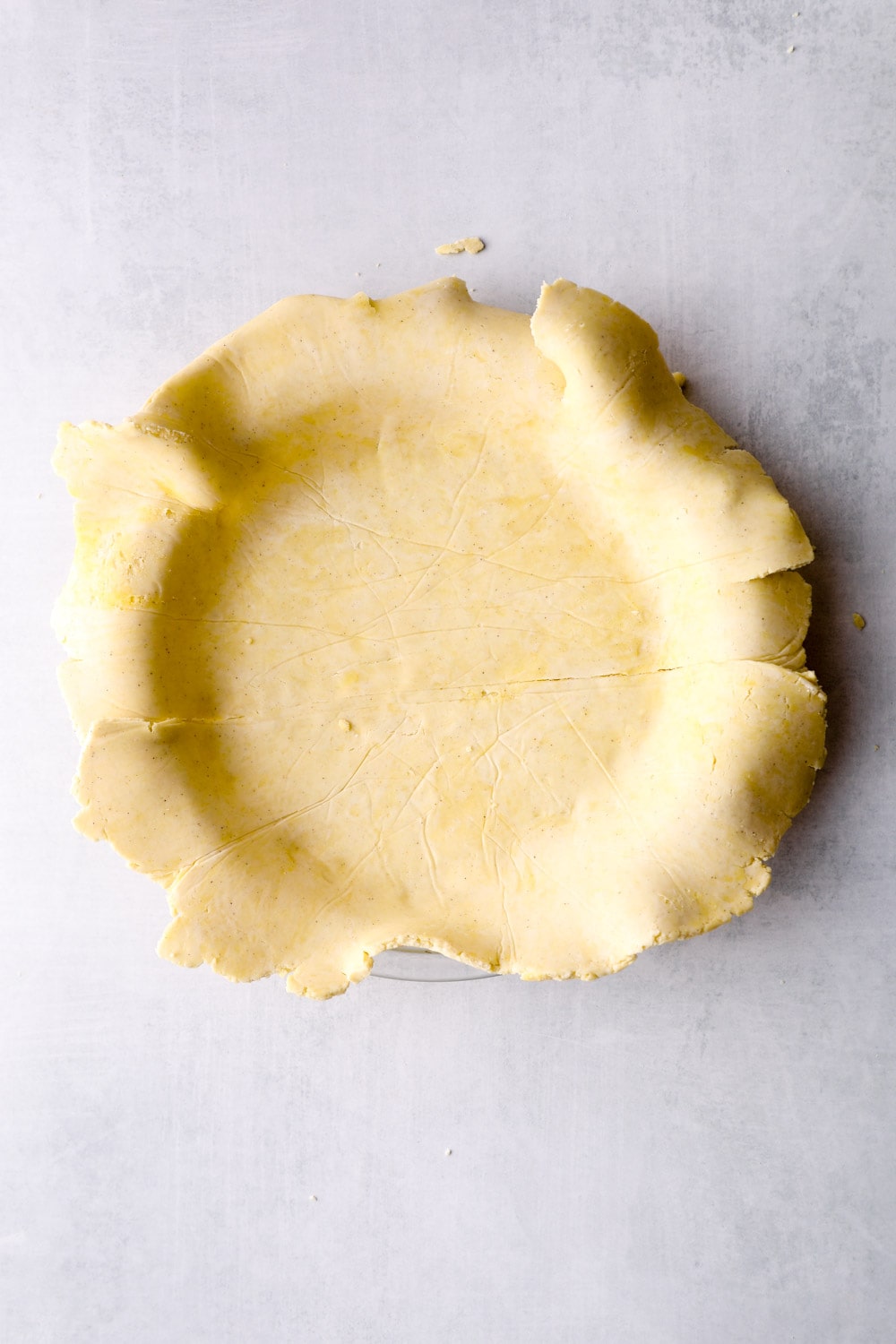
[one-half]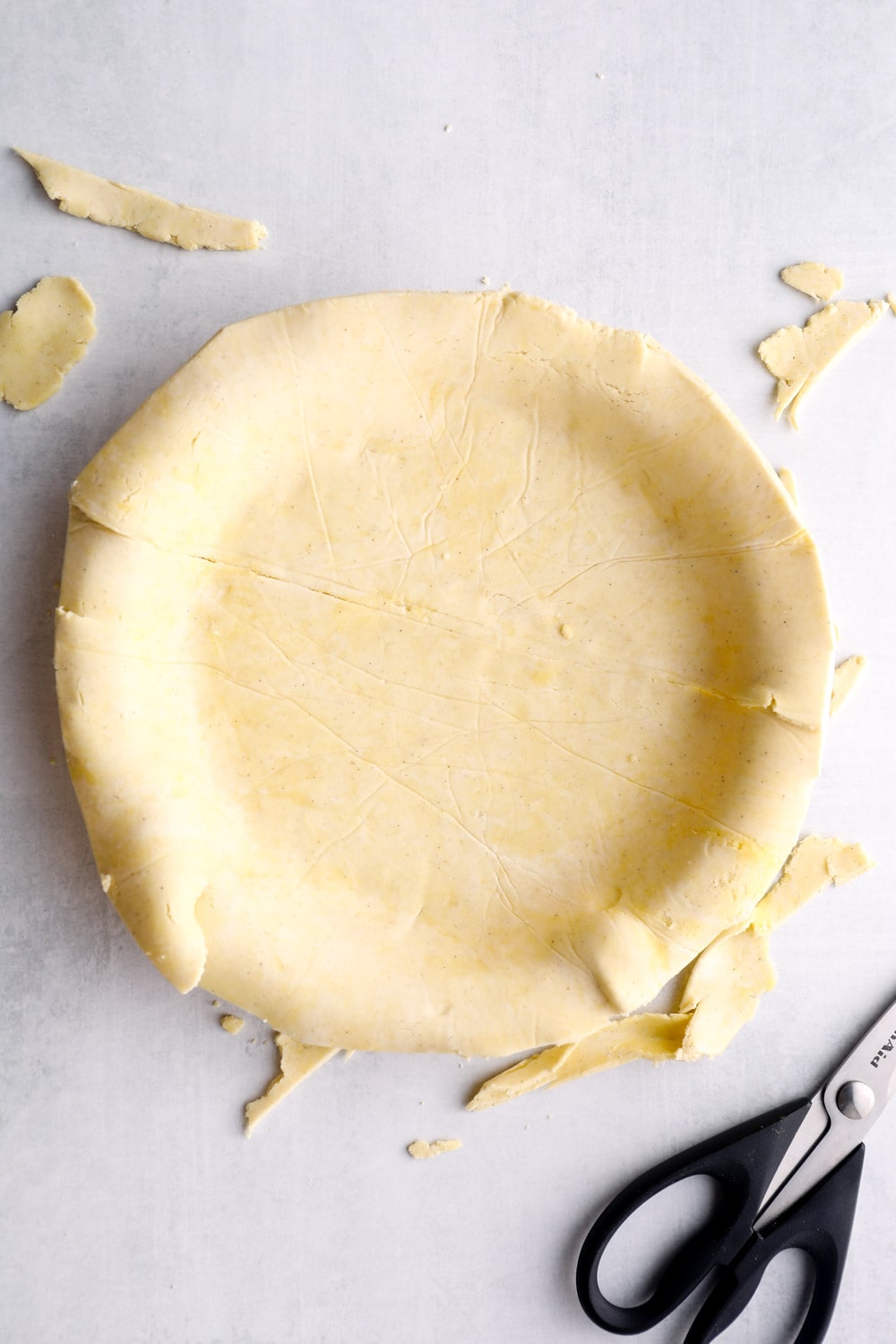
How to use this pie crust in a recipe:
Once you have the crust made, stop before baking and read the instructions on the recipe you are using. Follow those as they will be best suited for the crust.
If the recipe is apple pie, or another fruit pie, you will likely add the filling into the unbaked crust and then bake.
If the recipe is a cream pie, you will likely bake the pie, filled with pie weights, before adding in the filling.
Sometimes, pumpkin and other pies, call for a "blind bake" where you partially bake the crust with pie weights before you fill the crust and bake again.
And other times, with pot pie, you'll simple lay the crust over the top of the dish, and press it to the side of the dish to seal.
Tips and tricks for perfect gluten free crust!
- Make sure all your ingredients are COLD. There are instructions for how to quick-chill the shortening in the recipe, but make sure your water and vodka are ice cold.
- Measure your water properly - water measurements do not include ice in the volume. Measure out ½ cup water and add ice just before using. Let chill for 1-2 minutes and add to the bowl.
- The dough will be drier than you think! Once the dough just barely comes together and is still crumbly, that's when you should stop adding water. The dough should hold together when pressed, but should still be sandy/crumbly in some places.
- If the dough has chilled for more than one hour, let it sit out at room temperature for 10-15 minutes to make it easier to roll.
- When rolling out the dough, roll it out between two pieces of parchment paper. This keeps the dough from sticking to your surface or rolling pin, and makes it SO easy to transfer to the pie plate.
- If the dough breaks when rolling, that's okay! It will likely happen. Peel back the top layer of parchment and fold the broken edges back over the rest of the dough. Place the top parchment back and continue rolling, the edges should smooth out.
More gluten free baking stables!
- Artisan Gluten Free Bread
- Perfect Gluten Free Pizza Dough
- Gluten Free Garlic Knots
- Amazing Gluten Free Cinnamon Rolls
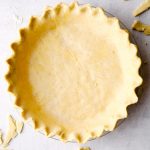
Gluten Free Pie Crust
- Prep Time: 10 minutes
- Cook Time: 80 minutes
- Total Time: 1 hour 30 minutes
- Category: Baking
- Method: Oven
- Cuisine: American
- Diet: Gluten Free
Description
Gluten Free Pie Crust that is flaky, tender and perfect for any type of pie! Plus lots of tips for making perfect crust!
Ingredients
- 2 cups Bob's Gluten Free 1 to 1 flour - use this blend for best results.
- ½ teaspoon baking powder
- ¼ teaspoon salt
- ½ cup plus 2 tablespoons vegetable shortening - we use Nutiva Vegetable Shortening in this recipe and recommend it for best results.
- 2 tablespoons cold vodka
- ½ plus 2 tablespoons cup ice cold water
Instructions
- To quickly chill your shortening, spread it out onto a small parchment lined baking sheet and place it in the freezer for 10 minutes. Once it is cold and firm to the touch, cut it into small ¼ inch pieces. Place back in the freezer until ready to use.
- Whisk the flour, baking powder, and salt together in a medium bowl.
- Add in the shortening and use a pastry cutter to cut it into the flour until only small bits remain.
- Sprinkle in the vodka and water. Stir with a spatula until combined. The dough will be crumbly, but should hold together when pressed. If it is too dry to come together, add in more water, a little at a time.
- Wrap the dough and plastic wrap and chill in the fridge for at least one hour.
- Roll the chilled dough out between two pieces of parchment paper. The edges will likely break when rolling, but don't worry! Peel back the top layer of parchment and fold the broken edges back over the rest of the dough. Place the top parchment back and continue rolling, the edges should smooth out.
- Peel off the top layer of parchment paper. Use the bottom piece of parchment to gently flip the dough into a 9 inch pie plate. Carefully peel off the remaining parchment.
- Ease the crust into the pie plate by lifting up on the edges and nestling it into the corners of the pie plate with your other hand. Trim off the excess dough, leaving a one inch boarder around the edge. Fold this excess under the dough so that the outer portion is twice as thick. Flute the edge of the crust.
- Use this finished crust as your pie recipe directs.
Notes
You can likely swap in another vegetable shortening brand or use vegan butter or regular butter.
To measure your water properly - water measurements do not include ice in the volume. Measure out ½ cup water and add ice just before using. Let chill for 1-2 minutes and add to the bowl.
The dough will be drier than you think! Once the dough just barely comes together and is still crumbly, that's when you should stop adding water. The dough should hold together when pressed, but should still be sandy/crumbly in some places.
If the dough has chilled for more than one hour, let it sit out at room temperature for 10-15 minutes to make it easier to roll.
Nutrition
- Serving Size: ⅛th crust
- Calories: 191
- Sugar: 0g
- Sodium: 150mg
- Fat: 16g
- Saturated Fat: 4g
- Carbohydrates: 8g
- Fiber: 0g
- Protein: 0g
- Cholesterol: 0mg


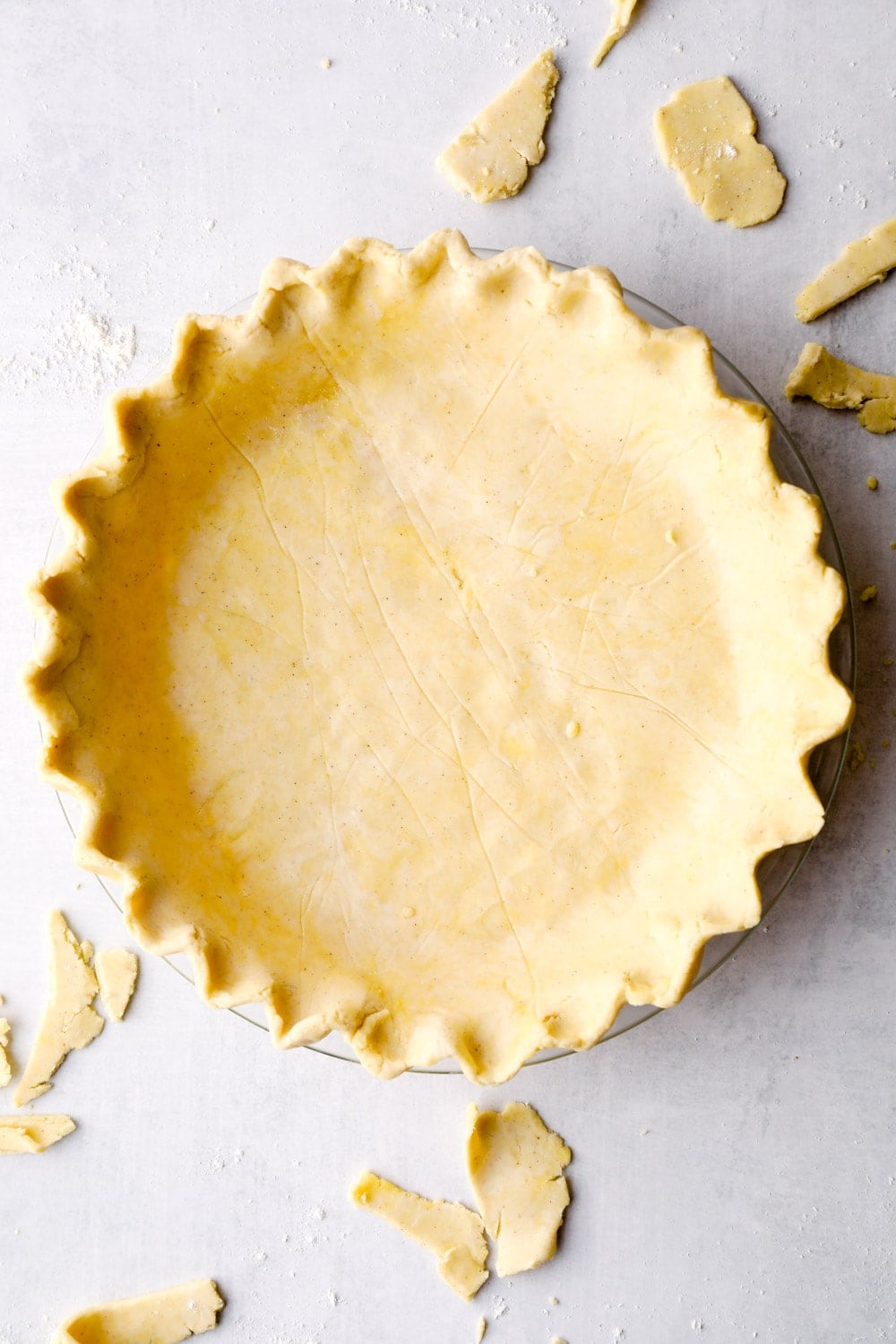

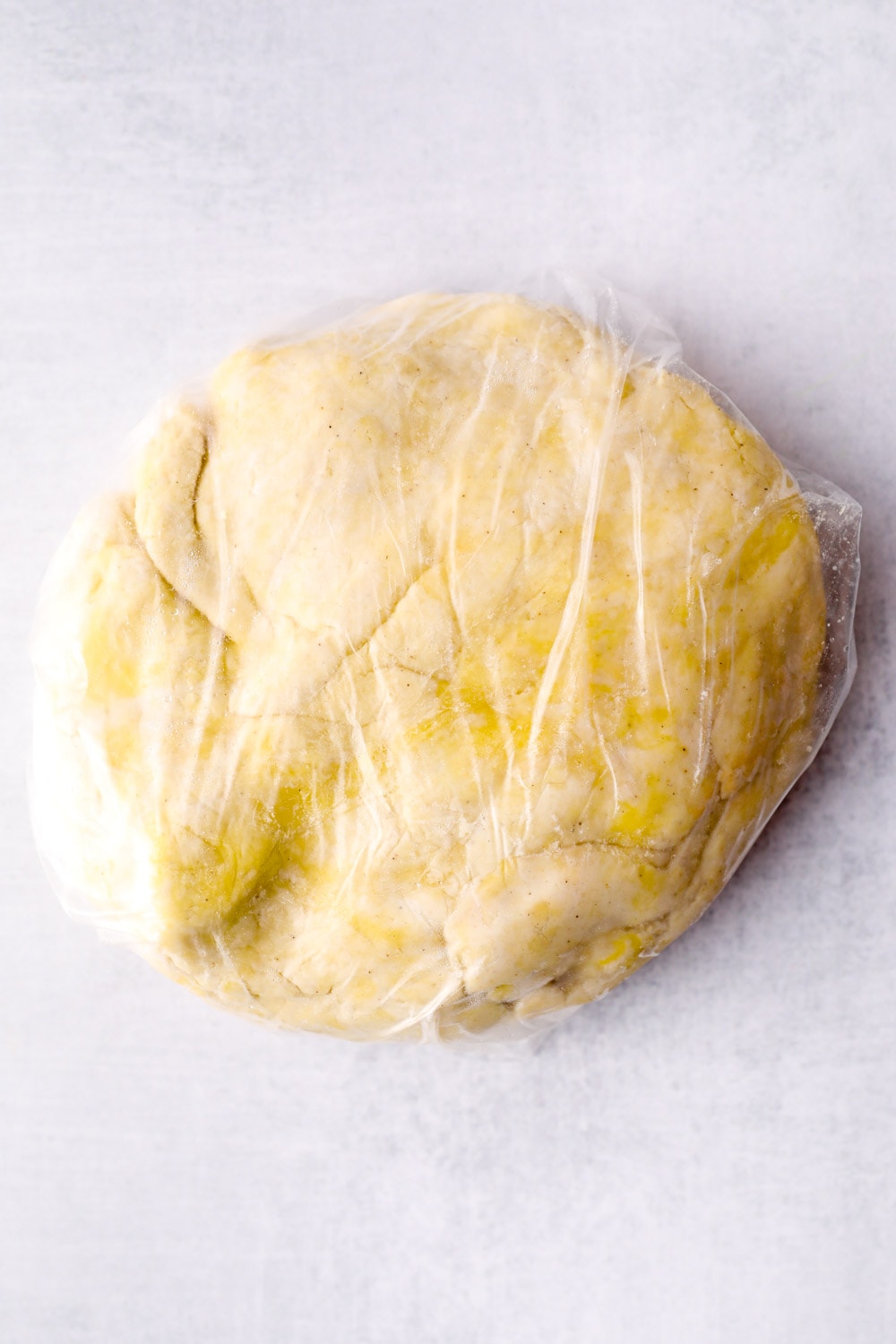

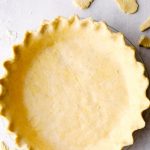

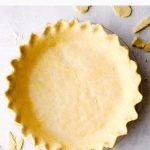
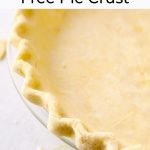
Hi. I don't think vodka is gluten free. What else could I substitute?
Hi Leah! Great question - experts believe that all vodka is gluten free and say that the distillation process removes all gluten. But, my recommendation is to bypass the grains all together and use a potato-based vodka! A lot of popular brands like Skyy, Smirnoff, Absolut, and Chopin are all potato based and are gluten free. The vodka really helps with the crusts texture, so use it if you can! If necessary, you can substitute more water, but note that the crust will not be as flaky. Please let me know if you have any more questions! I've linked a few resources below :) Happy baking!
https://www.totalwine.com/shop/popular-potato-vodkas
https://www.beyondceliac.org/gluten-free-diet/is-it-gluten-free/liquor/vodka/
I was told shortening contained traces of gluten. Is that wrong?
Hi Julie, I actually haven't heard that before, though I've learned anything is possible when it comes to gluten! I haven't noticed and adverse reactions in myself when using this brand. You can also substitute butter in place of the shortening. Happy baking!
Amazing recipe and my go-to pie crust for both sweet and savory recipes!
Would white vinegar work instead of vodka? Would you recommend blind baking at all for a pumpkin pie using this crust? I love your blog!
Hi Eugenie! Great question. Vinegar should work, and so will water. Use whatever you prefer :) I would not blind bake it for pumpkin pie - I was just testing this last week and it works great without any pre-baking. Thank you for being here! Happy baking!
I was wondering if this crust would make fry pies where you are taking a circle and folding it in half or would it crack and break apart?
Hi Margaret, I haven't tested the crust with fry pies, so I can't say for sure. If you give it a try, please let me know how it holds up!